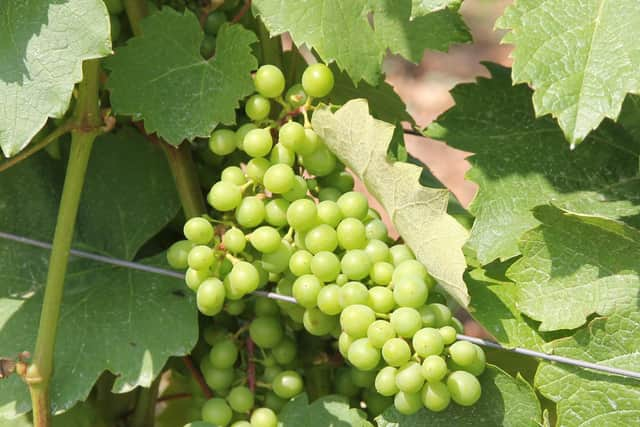Furmint is Hungary's best kept wine secret and one well worth exploring


There’s Bull’s Blood – which isn’t a grape, but it is so famous it might as well be. But the rest are shrouded in accents and rather too many k and z letters to really commit them to memory.
There are 184 varieties listed in Hungary, planted across its 58,000 hectares of vineyards. This is more vineyards than Austria and less than Germany, however it wasn’t always like this. Back in the 18th century, Hungary – which was a lot bigger in those days – was the third largest wine producer in the world.
Advertisement
Hide AdAdvertisement
Hide AdIf there is one wine that most people know about from Hungary it is Tokaji. Known as the sweet wine that goes wonderfully with chocolate, sticky toffee pudding and cheese, it comes from the north east of Hungary in a region that is pock-marked with around 380 extinct volcanoes. The south facing slopes of these hills are particularly good for grapes and the Tokaj region is a continuation of these hills, based on volcanic soils which give well-structured wines.


The main point to understand is that Tokaji isn’t just a sweet wine – Tokaj (identical pronunciation) is a region, which means that wines other than the unctuously sweet ones, known as Aszú, can also be produced. And that is where the grape Furmint comes in.
Furmint is one of the key grapes for making sweet Tokaji wines. It has a thick skin, which makes it tolerant to noble rot, and it has high acidity which balances the eventual sweetness of these wines.
But making those gorgeous sweet wines is a difficult process. Grapes are often picked one at a time when they hit the exact moment to make sweet wines and while the wines are delicious, they are perhaps not to everyone’s taste. Climate change is limiting the amount of noble rot that appears, and as one Hungarian producer told me: “If I rely on making just sweet wines, I would be bankrupt in a year.”
Advertisement
Hide AdAdvertisement
Hide AdThe real key to the Tokaj region is that Furmint can be made into dry wines too. Despite its unusual name, Furmint has genetic links to Chardonnay, Riesling and Gouais Blanc which is the granddaddy of many grape varieties.
With good viticulture and winemaking, Furmint makes extremely good dry white wines with a new set of flavours, someway between a Chablis and Sancerre, that go extremely well with food.
Switching from sweet wine production to dry is not as simple as it sounds. For a start, the vineyards that produce grapes with the vital noble rot for sweet wines are no good for dry wines. The last thing grapes need for dry wine production is rot, so it makes sense to use only grapes from the vineyards above the fog-line in the hills of Tokaj.
Once that is recognised, then there are many factors that affect the flavours of Furmint dry wines. The volcanic soils impart minerally overtones, giving structure and complexity to the wines. Yield is also important. When pruned to achieve a lower crop, the pear, quince and apple flavours develop into apricot and an edge of spice.
Advertisement
Hide AdAdvertisement
Hide AdGrape varietal clones also play a part. Political history moves so fast it is difficult to remember that Hungary was under Soviet occupation until 1991. During that period the main aim of vineyards was to provide large quantities of sweet wines for export to the Soviet Union. Grape varieties were selected and planted for their ability to make these wines, and some better clones were not encouraged.
Now there are different aims and new clones are being found and planted. Ancient vines from pre-Soviet days are particularly prized.
Another vital part of the grape revolution is investment. Initially there was massive investment from wine companies outside Hungary, but now there is a resurgence of family-owned Hungarian companies who can see their way forward in the international market.
Tokaj is not the only part of Hungary developing its dry Furmint wines. There are wines from Eger, Somló and the beautiful vineyards close to Lake Balaton.
Advertisement
Hide AdAdvertisement
Hide AdIf you haven’t tried a Furmint wine, now is the time to take a leap of faith and pick up a bottle. Start with a great value wine, and then move up the scale to see how this grape adds another segment of flavours to your drinking repertoire.
Furmint is particularly good with fish. Try seared scallops, grilled sea bass and lobster, but it also sits well alongside chicken and a firm cheese such as Comté.
Here are some wines to start with...
Taste the Difference Dry Furmint 2019, Royal Tokaji, Hungary, Sainsbury £10: This comes from Royal Tokaji, a company set up in the early days of independence, made up of top producers and wine professionals. It is renowned for its quality wines and it is good to see these wines on a supermarket shelf. Expect ripe, rounded fruit with white peach, pear and almost a touch of herbs. There is a distinct, edgy mineral finish which adds weight and complexity.
Patricius Dry Furmint 2019, Tokaj, Waitrose £9.99: From a long-established family company, this has all the characteristic minerally depth but it also has lip-smacking, lemony notes with a touch of peach and ripe quince.
Advertisement
Hide AdAdvertisement
Hide AdKardos Furmint 2019, Mád, Tokaj, Cellar Selected (01422 416200) £10.90: The wonderfully named village of Mád is regarded as one of the best areas of Tokaj, and the Kardos estate has been growing grapes there for centuries. Now with the young generation in charge of vineyards and winery, quality is high. This wine has citrus notes on the nose, pear and grapefruit on the palate and a firm minerally finish.
Disznoko Tokaji Dry Furmint 2019, Ocado £12.99: Owned by the insurance company AXA, which also owns many important wine estates across Europe, this winery sits in the middle of its vineyards, clearly plump with investment and with all the right equipment to make superlative wines. This Furmint is fresh tasting with juicy, ripe pear fruit, backed by citrus and with a chalky, minerally finish.